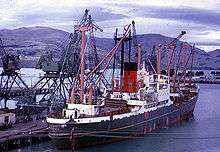Union Company
.jpg)
The Union Steam Ship Company of New Zealand, also known as the Union Company, Union Steam Ship Company (USS Co), or Union Line, was once the biggest shipping line in the southern hemisphere and New Zealand's largest private-sector employer. It was founded by James Mills in Dunedin in 1875.[1]
History

James Mills had worked for Johnny Jones and his Harbour Steam Company. After Jones’ death in 1869, Mills floated the Union Company in 1875 with backing from Scottish shipbuilder Peter Denny in return for orders for his Dumbarton shipyard. The Union Company became a major shipping line, with a near-monopoly on trans-Tasman shipping, and was referred to as the "Southern Octopus".[1]
From 1889 there was a three-way competition between the Union Steamship Company, Huddart Parker and the Tasmanian Steam Navigation Company (TSNCo) on the Tasmanian routes (Melbourne – Launceston, Hobart – Melbourne and Hobart – Sydney). The TSNCo did not have other routes to absorb their Tasmanian losses, and was bought out by the USSCo in 1891. The rivalry between the USSCo and Huddart Parker lasted to 1895 despite an earlier agreement in 1893. There was undercutting by cheap fares and steamers shadowing each other from port to port. The USSCo Rotomahana and Mararoa would sail alongside the Miowra and Warrimoo, with other ships e.g. the Te Anau and Manapouri sailing before and after so bracketing the Huddart Parker ships. The 1895 agreement between the two lines pooled the Auckland-Sydney profits and losses; the Melbourne-Launceston profits were divided 4/7 to the USSCo and 3/7 to Huddart Parker; and the Sydney-Hobart passenger trade was excluded but the cargo and stock trade was divided 2/3 to USSCo and 1/3 to Huddart Parker.[2]
In 1897 Mark Twain criticised travel conditions on a Union Company ship in his travel book Following the Equator.
By 1914 the Union Company had 75 ships. It was the biggest shipping line in the southern hemisphere and New Zealand's largest private-sector employer. Mills sold the company to the British Peninsular and Oriental Steam Navigation Company (P&O) in 1917. Mills was knighted in 1907 and K.C.M.G. in 1909. He was a UK resident from 1907, and died in London.[1]
.jpg)

The company began regular sailings between Wellington and Lyttelton with the Penguin making two round trips a week in 1895. In 1905 this had become a daily service year round. In 1933 the name "Steamer Express" was adopted for the service.[3] Over the years a number of ships were used, including two Maoris, two Wahines, two Rangatiras, and a Hinemoa.[4]
In what has been described as "a fatal mistake",[5] the Union Company announced in 1956 that the Tamahine was to be withdrawn from the Wellington-Picton route in 1962 and unlikely to be replaced (despite an offer of a $3 million government loan).[6] The designer of the replacement ferry recalled that, "The media said the whole thing was a red herring", adding, "In their view, if the Union Steam Ship Company couldn’t make the service pay, Railways definitely couldn’t."[7]
TEV Wahine entered service in 1966 and foundered and sank at the mouth of Wellington Harbour in 1968. The TEV Rangatira entered service in 1972 and was withdrawn in 1976, bringing the Wellington–Lyttelton "Steamer Express" to an end.[3]
By 1990, the company operated seven ships, and was involved in ship management, tourism, real estate and other ventures. By 2000, the Union Bulk[8] barge made its last voyage.[9]
The Union Company, Union Steam Ship Company, or Union Line has owned more than 350 ships, and has been the subject of a number of books.
See also
| Wikimedia Commons has media related to Union Steamship Company of New Zealand. |
- Category:Ships of the Union Steam Ship Company
- Union Airways of N.Z. Ltd — Union Line's airline subsidiary
Notes
- 1 2 3 McLean, Gavin (20 November 2013). "Mills, James". Te Ara – the Encyclopedia of New Zealand.
- ↑ McLean 1990, pp. 49–66.
- 1 2 "Steamer Express". New Zealand Coastal Shipping. Retrieved 8 February 2015.
- ↑ McLean, Gavin (13 July 2012). "Shipping - The Union Company expands". Te Ara – the Encyclopedia of New Zealand.
- ↑ McLean, Gavin (2009). A Voice for Shipping (PDF). New Zealand Shipping Federation Inc. p. 60. ISBN 978-1-877448-76-8.
- ↑ "COOK STRAIT RAIL FERRIES - The New Zealand Maritime Record - NZNMM". www.nzmaritime.co.nz. Retrieved 2016-03-29.
- ↑ "Cook-Strait ferries changed the nature of shipping in New Zealand" (PDF). The Marlborough Express. 2012.
- ↑ "New Zealand Maritime Index from NZNMM". www.nzmaritimeindex.org.nz. Retrieved 2016-03-29.
- ↑ "Union Steam Ship Company flag - NZHistory, New Zealand history online". www.nzhistory.net.nz. Retrieved 2016-03-29.
Bibliography
- Farquhar, Ian (2001). Union Fleet. Wellington, NZ: New Zealand Ship & Marine Society. ISBN 0959783474.
- McGregor, Rae (2009). Sailing to Success: The Union Company Cadet Scheme. Wellington, N.Z.: New Zealand Ship & Marine Society on behalf of Union Company Cadets Reunion Committee. ISBN 9780473152178.
- McLean, Gavin (1989). Ships of the Union Company. Wellington, NZ: GP Government Print. ISBN 0-477-00016-9.
- McLean, Gavin (1990). The Southern Octopus. Wellington, NZ: New Zealand Ship and Marine Society & Wellington Maritime Museum. ISBN 0959783431.
- McLauchlan, Gordon (1987). The Line that Dared: A history of the Union Steam Ship Company 1875–1975. Auckland: Four Star Books. ISBN 0-9597853-0-2.
External links
- Article in 1966 Encyclopaedia of New Zealand
- Article in Te Ara online Encyclopaedia
- Union Steam Ship Company by Gavin McLean on New Zealand Ship & Marine Society website
- Lyttelton-Wellington ferries (NZHistory.net.nz)
- colour photo of ferries Rangatira and Maori at Picton in 1959
